Innovation and Commercialisation Report for Nix Communications
VerifiedAdded on 2020/01/23
|11
|3792
|126
Report
AI Summary
This report examines innovation and commercialization strategies within Nix Communications, a telecom company. It explores the significance of innovation and commercialization, emphasizing the roles of culture, vision, teamwork, and leadership. The report delves into various sources of innovation, the application of the 4 P's of innovation, and the use of innovation funnels. It also discusses frugal innovation and its organizational implications, as well as the development and measurement of innovation. Furthermore, the report covers the importance of the commercial funnel and New Product Development (NPD) processes, including the creation of an innovation business case, knowledge and intellectual property protection, and their evaluation within the broader business environment. The report concludes with critical evaluations and provides a comprehensive analysis of innovation challenges and solutions within Nix Communications, highlighting its efforts to boost profitability through innovative service offerings.
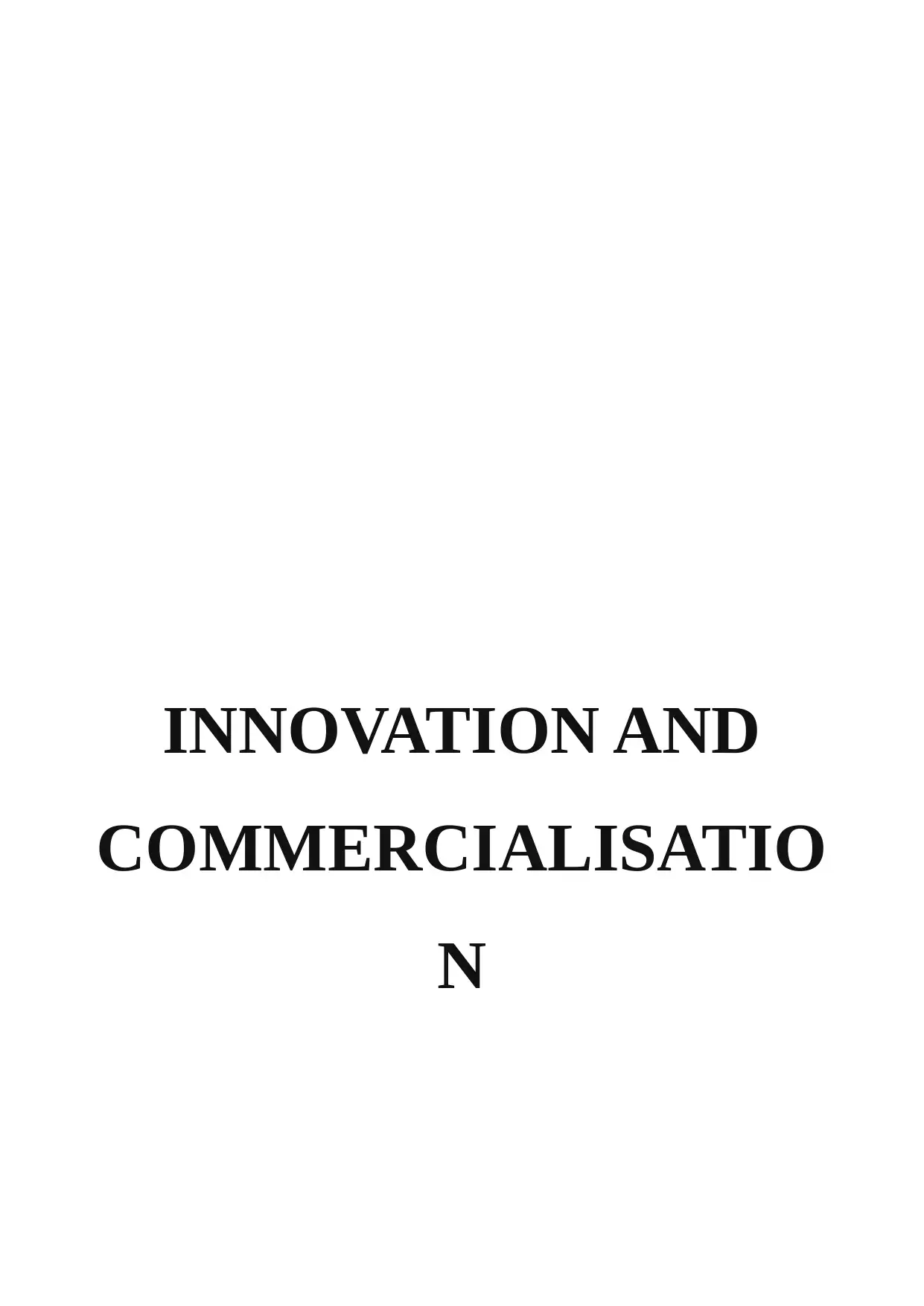
INNOVATION AND
COMMERCIALISATIO
N
COMMERCIALISATIO
N
Paraphrase This Document
Need a fresh take? Get an instant paraphrase of this document with our AI Paraphraser
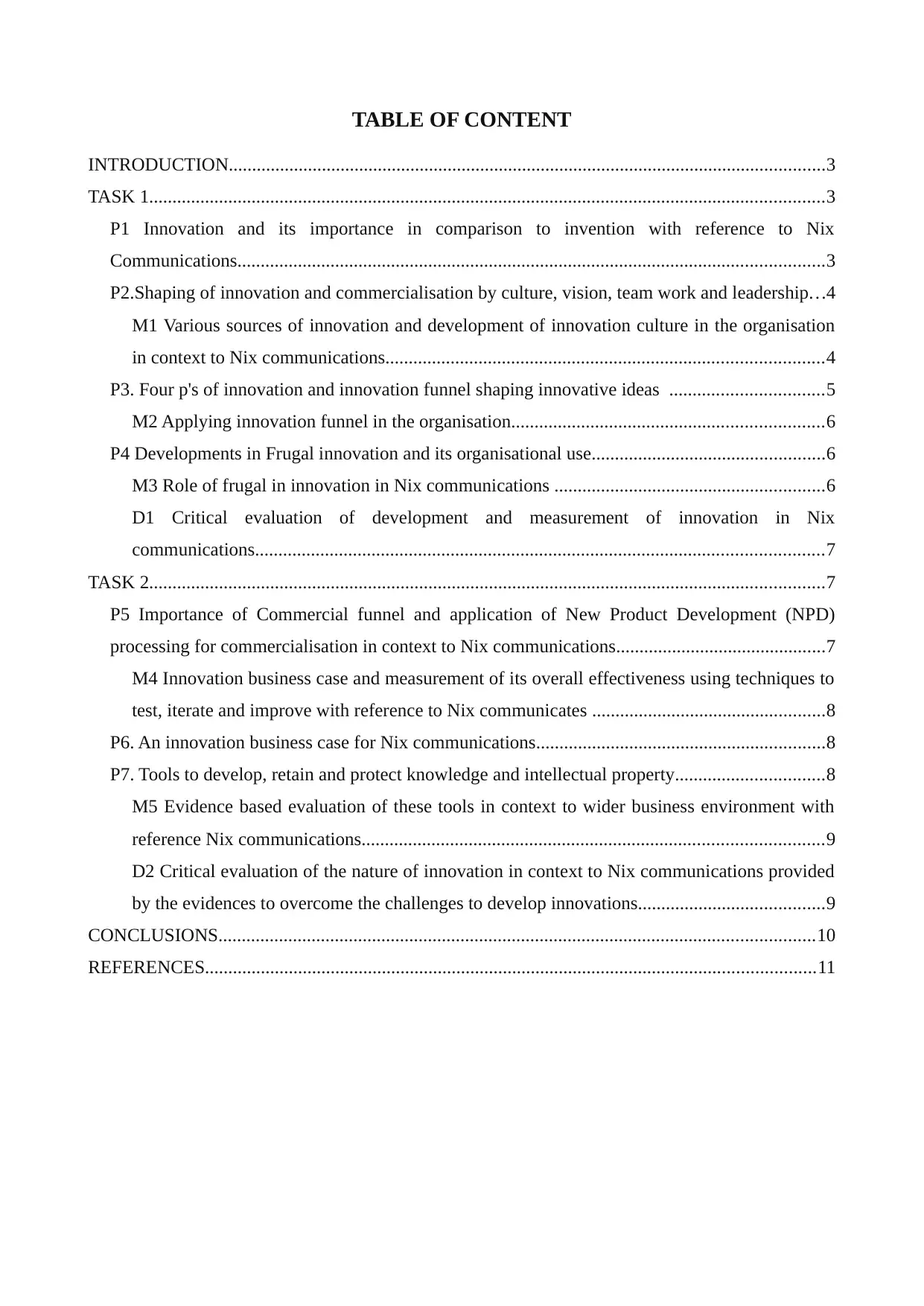
TABLE OF CONTENT
INTRODUCTION................................................................................................................................3
TASK 1.................................................................................................................................................3
P1 Innovation and its importance in comparison to invention with reference to Nix
Communications..............................................................................................................................3
P2.Shaping of innovation and commercialisation by culture, vision, team work and leadership...4
M1 Various sources of innovation and development of innovation culture in the organisation
in context to Nix communications..............................................................................................4
P3. Four p's of innovation and innovation funnel shaping innovative ideas .................................5
M2 Applying innovation funnel in the organisation...................................................................6
P4 Developments in Frugal innovation and its organisational use..................................................6
M3 Role of frugal in innovation in Nix communications ..........................................................6
D1 Critical evaluation of development and measurement of innovation in Nix
communications..........................................................................................................................7
TASK 2.................................................................................................................................................7
P5 Importance of Commercial funnel and application of New Product Development (NPD)
processing for commercialisation in context to Nix communications.............................................7
M4 Innovation business case and measurement of its overall effectiveness using techniques to
test, iterate and improve with reference to Nix communicates ..................................................8
P6. An innovation business case for Nix communications..............................................................8
P7. Tools to develop, retain and protect knowledge and intellectual property................................8
M5 Evidence based evaluation of these tools in context to wider business environment with
reference Nix communications...................................................................................................9
D2 Critical evaluation of the nature of innovation in context to Nix communications provided
by the evidences to overcome the challenges to develop innovations........................................9
CONCLUSIONS................................................................................................................................10
REFERENCES...................................................................................................................................11
INTRODUCTION................................................................................................................................3
TASK 1.................................................................................................................................................3
P1 Innovation and its importance in comparison to invention with reference to Nix
Communications..............................................................................................................................3
P2.Shaping of innovation and commercialisation by culture, vision, team work and leadership...4
M1 Various sources of innovation and development of innovation culture in the organisation
in context to Nix communications..............................................................................................4
P3. Four p's of innovation and innovation funnel shaping innovative ideas .................................5
M2 Applying innovation funnel in the organisation...................................................................6
P4 Developments in Frugal innovation and its organisational use..................................................6
M3 Role of frugal in innovation in Nix communications ..........................................................6
D1 Critical evaluation of development and measurement of innovation in Nix
communications..........................................................................................................................7
TASK 2.................................................................................................................................................7
P5 Importance of Commercial funnel and application of New Product Development (NPD)
processing for commercialisation in context to Nix communications.............................................7
M4 Innovation business case and measurement of its overall effectiveness using techniques to
test, iterate and improve with reference to Nix communicates ..................................................8
P6. An innovation business case for Nix communications..............................................................8
P7. Tools to develop, retain and protect knowledge and intellectual property................................8
M5 Evidence based evaluation of these tools in context to wider business environment with
reference Nix communications...................................................................................................9
D2 Critical evaluation of the nature of innovation in context to Nix communications provided
by the evidences to overcome the challenges to develop innovations........................................9
CONCLUSIONS................................................................................................................................10
REFERENCES...................................................................................................................................11
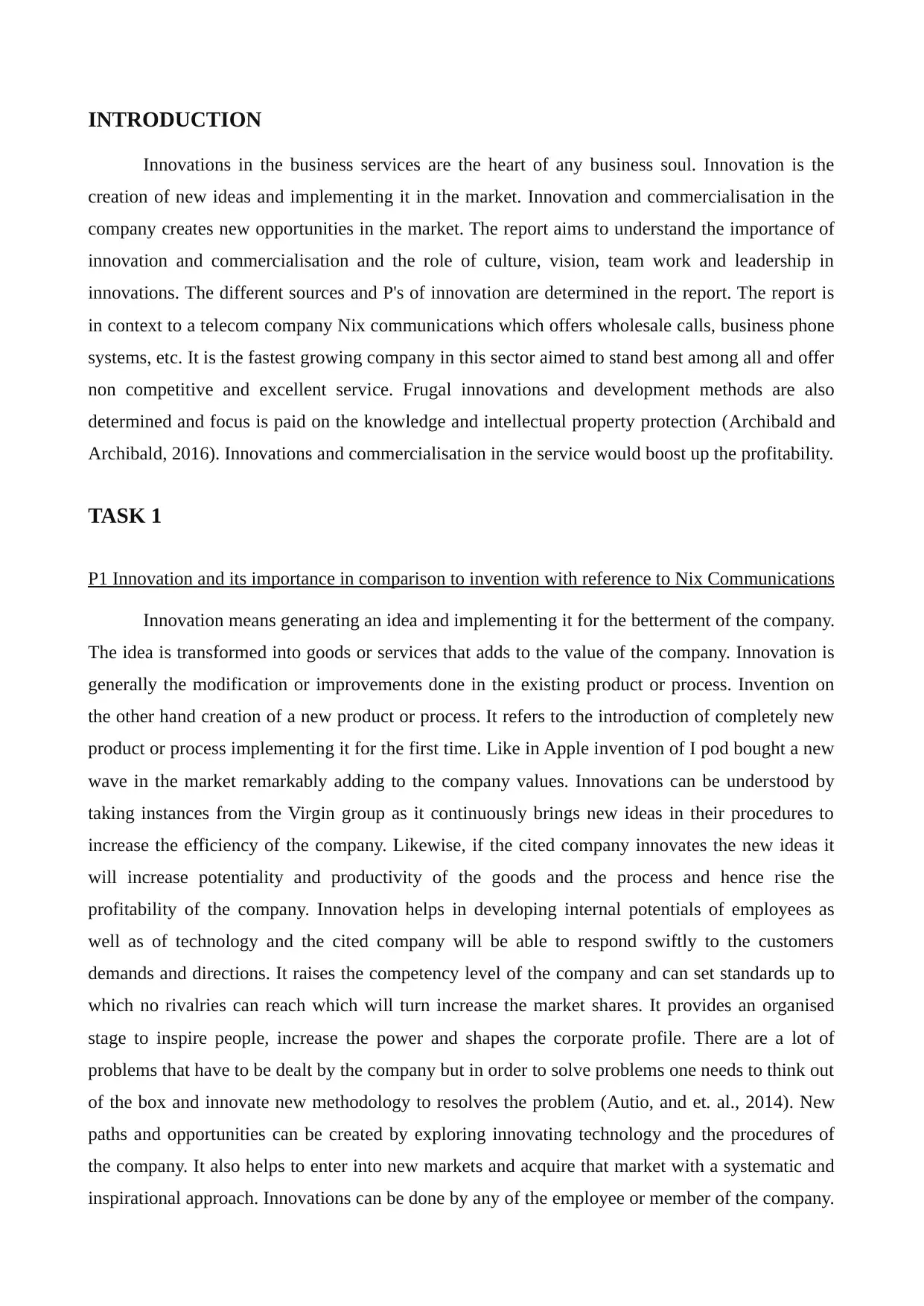
INTRODUCTION
Innovations in the business services are the heart of any business soul. Innovation is the
creation of new ideas and implementing it in the market. Innovation and commercialisation in the
company creates new opportunities in the market. The report aims to understand the importance of
innovation and commercialisation and the role of culture, vision, team work and leadership in
innovations. The different sources and P's of innovation are determined in the report. The report is
in context to a telecom company Nix communications which offers wholesale calls, business phone
systems, etc. It is the fastest growing company in this sector aimed to stand best among all and offer
non competitive and excellent service. Frugal innovations and development methods are also
determined and focus is paid on the knowledge and intellectual property protection (Archibald and
Archibald, 2016). Innovations and commercialisation in the service would boost up the profitability.
TASK 1
P1 Innovation and its importance in comparison to invention with reference to Nix Communications
Innovation means generating an idea and implementing it for the betterment of the company.
The idea is transformed into goods or services that adds to the value of the company. Innovation is
generally the modification or improvements done in the existing product or process. Invention on
the other hand creation of a new product or process. It refers to the introduction of completely new
product or process implementing it for the first time. Like in Apple invention of I pod bought a new
wave in the market remarkably adding to the company values. Innovations can be understood by
taking instances from the Virgin group as it continuously brings new ideas in their procedures to
increase the efficiency of the company. Likewise, if the cited company innovates the new ideas it
will increase potentiality and productivity of the goods and the process and hence rise the
profitability of the company. Innovation helps in developing internal potentials of employees as
well as of technology and the cited company will be able to respond swiftly to the customers
demands and directions. It raises the competency level of the company and can set standards up to
which no rivalries can reach which will turn increase the market shares. It provides an organised
stage to inspire people, increase the power and shapes the corporate profile. There are a lot of
problems that have to be dealt by the company but in order to solve problems one needs to think out
of the box and innovate new methodology to resolves the problem (Autio, and et. al., 2014). New
paths and opportunities can be created by exploring innovating technology and the procedures of
the company. It also helps to enter into new markets and acquire that market with a systematic and
inspirational approach. Innovations can be done by any of the employee or member of the company.
Innovations in the business services are the heart of any business soul. Innovation is the
creation of new ideas and implementing it in the market. Innovation and commercialisation in the
company creates new opportunities in the market. The report aims to understand the importance of
innovation and commercialisation and the role of culture, vision, team work and leadership in
innovations. The different sources and P's of innovation are determined in the report. The report is
in context to a telecom company Nix communications which offers wholesale calls, business phone
systems, etc. It is the fastest growing company in this sector aimed to stand best among all and offer
non competitive and excellent service. Frugal innovations and development methods are also
determined and focus is paid on the knowledge and intellectual property protection (Archibald and
Archibald, 2016). Innovations and commercialisation in the service would boost up the profitability.
TASK 1
P1 Innovation and its importance in comparison to invention with reference to Nix Communications
Innovation means generating an idea and implementing it for the betterment of the company.
The idea is transformed into goods or services that adds to the value of the company. Innovation is
generally the modification or improvements done in the existing product or process. Invention on
the other hand creation of a new product or process. It refers to the introduction of completely new
product or process implementing it for the first time. Like in Apple invention of I pod bought a new
wave in the market remarkably adding to the company values. Innovations can be understood by
taking instances from the Virgin group as it continuously brings new ideas in their procedures to
increase the efficiency of the company. Likewise, if the cited company innovates the new ideas it
will increase potentiality and productivity of the goods and the process and hence rise the
profitability of the company. Innovation helps in developing internal potentials of employees as
well as of technology and the cited company will be able to respond swiftly to the customers
demands and directions. It raises the competency level of the company and can set standards up to
which no rivalries can reach which will turn increase the market shares. It provides an organised
stage to inspire people, increase the power and shapes the corporate profile. There are a lot of
problems that have to be dealt by the company but in order to solve problems one needs to think out
of the box and innovate new methodology to resolves the problem (Autio, and et. al., 2014). New
paths and opportunities can be created by exploring innovating technology and the procedures of
the company. It also helps to enter into new markets and acquire that market with a systematic and
inspirational approach. Innovations can be done by any of the employee or member of the company.
⊘ This is a preview!⊘
Do you want full access?
Subscribe today to unlock all pages.

Trusted by 1+ million students worldwide
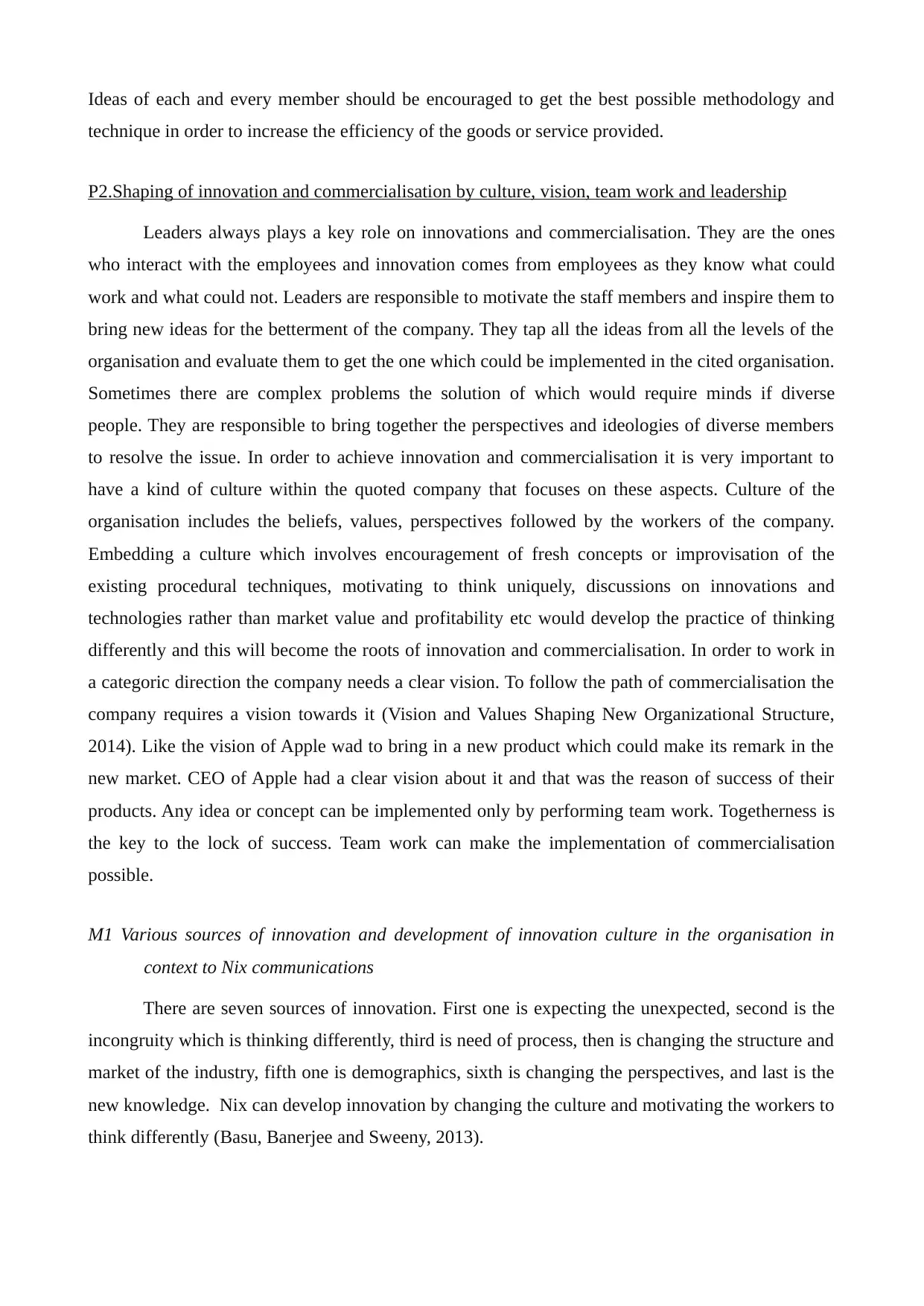
Ideas of each and every member should be encouraged to get the best possible methodology and
technique in order to increase the efficiency of the goods or service provided.
P2.Shaping of innovation and commercialisation by culture, vision, team work and leadership
Leaders always plays a key role on innovations and commercialisation. They are the ones
who interact with the employees and innovation comes from employees as they know what could
work and what could not. Leaders are responsible to motivate the staff members and inspire them to
bring new ideas for the betterment of the company. They tap all the ideas from all the levels of the
organisation and evaluate them to get the one which could be implemented in the cited organisation.
Sometimes there are complex problems the solution of which would require minds if diverse
people. They are responsible to bring together the perspectives and ideologies of diverse members
to resolve the issue. In order to achieve innovation and commercialisation it is very important to
have a kind of culture within the quoted company that focuses on these aspects. Culture of the
organisation includes the beliefs, values, perspectives followed by the workers of the company.
Embedding a culture which involves encouragement of fresh concepts or improvisation of the
existing procedural techniques, motivating to think uniquely, discussions on innovations and
technologies rather than market value and profitability etc would develop the practice of thinking
differently and this will become the roots of innovation and commercialisation. In order to work in
a categoric direction the company needs a clear vision. To follow the path of commercialisation the
company requires a vision towards it (Vision and Values Shaping New Organizational Structure,
2014). Like the vision of Apple wad to bring in a new product which could make its remark in the
new market. CEO of Apple had a clear vision about it and that was the reason of success of their
products. Any idea or concept can be implemented only by performing team work. Togetherness is
the key to the lock of success. Team work can make the implementation of commercialisation
possible.
M1 Various sources of innovation and development of innovation culture in the organisation in
context to Nix communications
There are seven sources of innovation. First one is expecting the unexpected, second is the
incongruity which is thinking differently, third is need of process, then is changing the structure and
market of the industry, fifth one is demographics, sixth is changing the perspectives, and last is the
new knowledge. Nix can develop innovation by changing the culture and motivating the workers to
think differently (Basu, Banerjee and Sweeny, 2013).
technique in order to increase the efficiency of the goods or service provided.
P2.Shaping of innovation and commercialisation by culture, vision, team work and leadership
Leaders always plays a key role on innovations and commercialisation. They are the ones
who interact with the employees and innovation comes from employees as they know what could
work and what could not. Leaders are responsible to motivate the staff members and inspire them to
bring new ideas for the betterment of the company. They tap all the ideas from all the levels of the
organisation and evaluate them to get the one which could be implemented in the cited organisation.
Sometimes there are complex problems the solution of which would require minds if diverse
people. They are responsible to bring together the perspectives and ideologies of diverse members
to resolve the issue. In order to achieve innovation and commercialisation it is very important to
have a kind of culture within the quoted company that focuses on these aspects. Culture of the
organisation includes the beliefs, values, perspectives followed by the workers of the company.
Embedding a culture which involves encouragement of fresh concepts or improvisation of the
existing procedural techniques, motivating to think uniquely, discussions on innovations and
technologies rather than market value and profitability etc would develop the practice of thinking
differently and this will become the roots of innovation and commercialisation. In order to work in
a categoric direction the company needs a clear vision. To follow the path of commercialisation the
company requires a vision towards it (Vision and Values Shaping New Organizational Structure,
2014). Like the vision of Apple wad to bring in a new product which could make its remark in the
new market. CEO of Apple had a clear vision about it and that was the reason of success of their
products. Any idea or concept can be implemented only by performing team work. Togetherness is
the key to the lock of success. Team work can make the implementation of commercialisation
possible.
M1 Various sources of innovation and development of innovation culture in the organisation in
context to Nix communications
There are seven sources of innovation. First one is expecting the unexpected, second is the
incongruity which is thinking differently, third is need of process, then is changing the structure and
market of the industry, fifth one is demographics, sixth is changing the perspectives, and last is the
new knowledge. Nix can develop innovation by changing the culture and motivating the workers to
think differently (Basu, Banerjee and Sweeny, 2013).
Paraphrase This Document
Need a fresh take? Get an instant paraphrase of this document with our AI Paraphraser
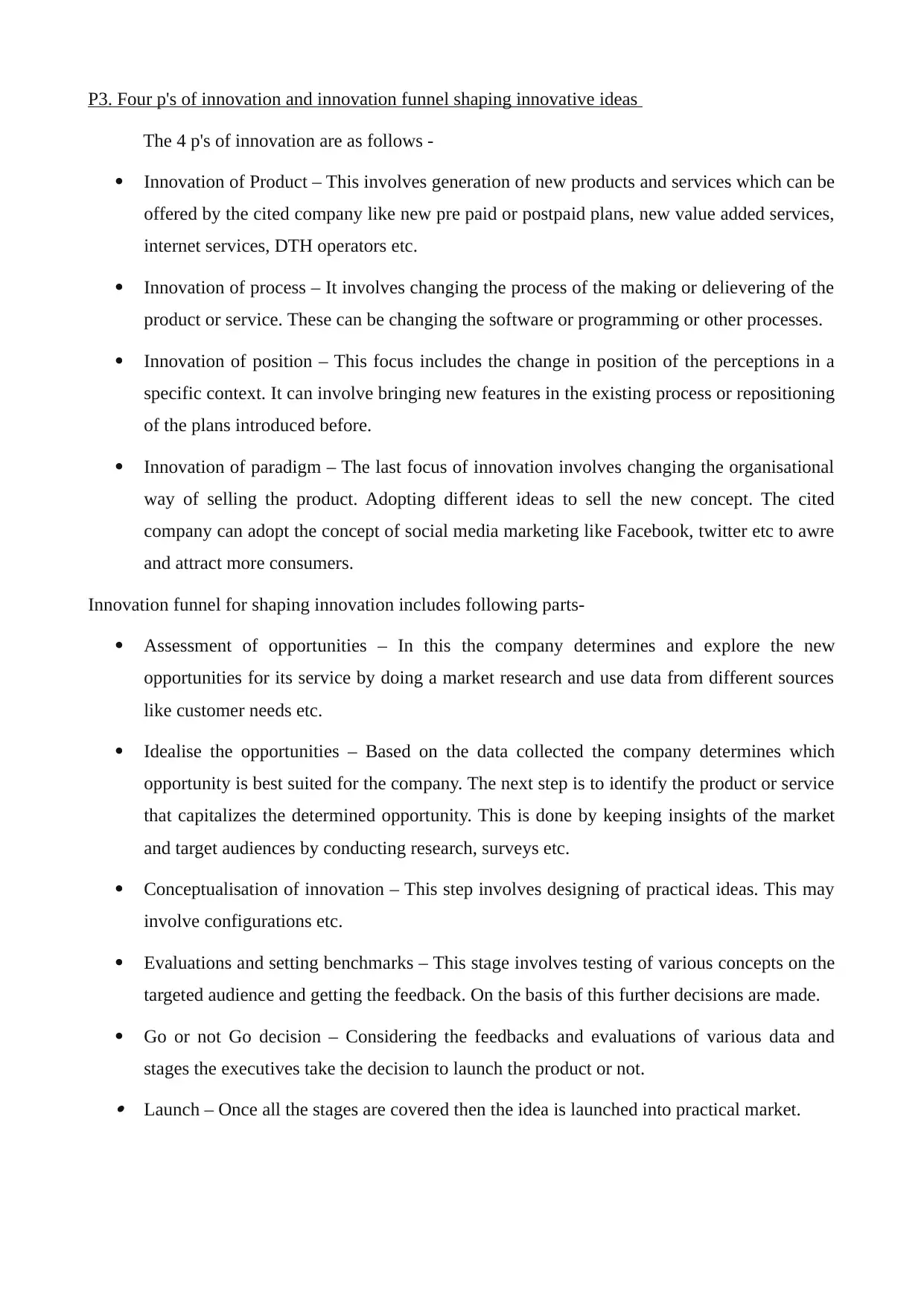
P3. Four p's of innovation and innovation funnel shaping innovative ideas
The 4 p's of innovation are as follows -
Innovation of Product – This involves generation of new products and services which can be
offered by the cited company like new pre paid or postpaid plans, new value added services,
internet services, DTH operators etc.
Innovation of process – It involves changing the process of the making or delievering of the
product or service. These can be changing the software or programming or other processes.
Innovation of position – This focus includes the change in position of the perceptions in a
specific context. It can involve bringing new features in the existing process or repositioning
of the plans introduced before.
Innovation of paradigm – The last focus of innovation involves changing the organisational
way of selling the product. Adopting different ideas to sell the new concept. The cited
company can adopt the concept of social media marketing like Facebook, twitter etc to awre
and attract more consumers.
Innovation funnel for shaping innovation includes following parts-
Assessment of opportunities – In this the company determines and explore the new
opportunities for its service by doing a market research and use data from different sources
like customer needs etc.
Idealise the opportunities – Based on the data collected the company determines which
opportunity is best suited for the company. The next step is to identify the product or service
that capitalizes the determined opportunity. This is done by keeping insights of the market
and target audiences by conducting research, surveys etc.
Conceptualisation of innovation – This step involves designing of practical ideas. This may
involve configurations etc.
Evaluations and setting benchmarks – This stage involves testing of various concepts on the
targeted audience and getting the feedback. On the basis of this further decisions are made.
Go or not Go decision – Considering the feedbacks and evaluations of various data and
stages the executives take the decision to launch the product or not.
Launch – Once all the stages are covered then the idea is launched into practical market.
The 4 p's of innovation are as follows -
Innovation of Product – This involves generation of new products and services which can be
offered by the cited company like new pre paid or postpaid plans, new value added services,
internet services, DTH operators etc.
Innovation of process – It involves changing the process of the making or delievering of the
product or service. These can be changing the software or programming or other processes.
Innovation of position – This focus includes the change in position of the perceptions in a
specific context. It can involve bringing new features in the existing process or repositioning
of the plans introduced before.
Innovation of paradigm – The last focus of innovation involves changing the organisational
way of selling the product. Adopting different ideas to sell the new concept. The cited
company can adopt the concept of social media marketing like Facebook, twitter etc to awre
and attract more consumers.
Innovation funnel for shaping innovation includes following parts-
Assessment of opportunities – In this the company determines and explore the new
opportunities for its service by doing a market research and use data from different sources
like customer needs etc.
Idealise the opportunities – Based on the data collected the company determines which
opportunity is best suited for the company. The next step is to identify the product or service
that capitalizes the determined opportunity. This is done by keeping insights of the market
and target audiences by conducting research, surveys etc.
Conceptualisation of innovation – This step involves designing of practical ideas. This may
involve configurations etc.
Evaluations and setting benchmarks – This stage involves testing of various concepts on the
targeted audience and getting the feedback. On the basis of this further decisions are made.
Go or not Go decision – Considering the feedbacks and evaluations of various data and
stages the executives take the decision to launch the product or not.
Launch – Once all the stages are covered then the idea is launched into practical market.
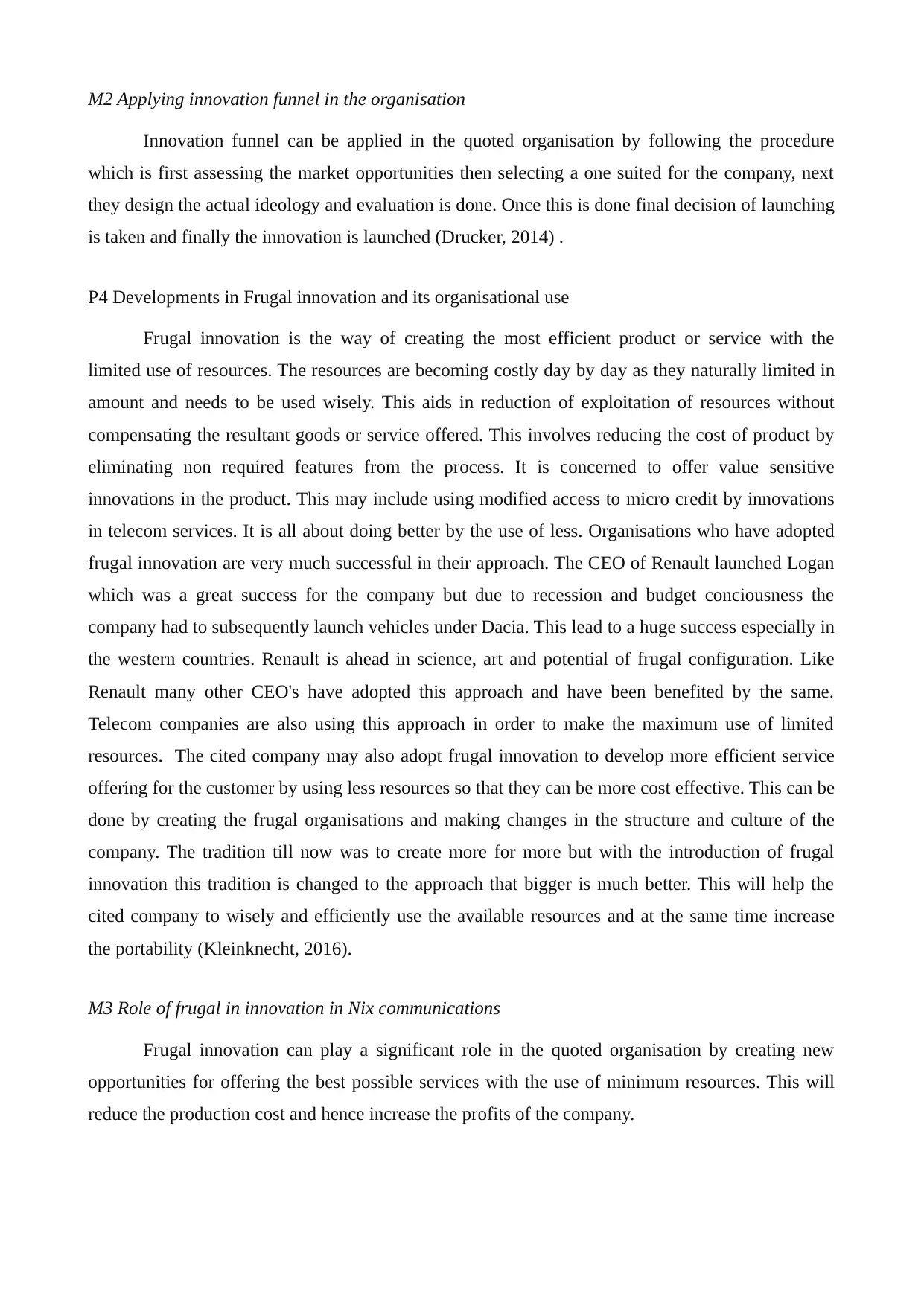
M2 Applying innovation funnel in the organisation
Innovation funnel can be applied in the quoted organisation by following the procedure
which is first assessing the market opportunities then selecting a one suited for the company, next
they design the actual ideology and evaluation is done. Once this is done final decision of launching
is taken and finally the innovation is launched (Drucker, 2014) .
P4 Developments in Frugal innovation and its organisational use
Frugal innovation is the way of creating the most efficient product or service with the
limited use of resources. The resources are becoming costly day by day as they naturally limited in
amount and needs to be used wisely. This aids in reduction of exploitation of resources without
compensating the resultant goods or service offered. This involves reducing the cost of product by
eliminating non required features from the process. It is concerned to offer value sensitive
innovations in the product. This may include using modified access to micro credit by innovations
in telecom services. It is all about doing better by the use of less. Organisations who have adopted
frugal innovation are very much successful in their approach. The CEO of Renault launched Logan
which was a great success for the company but due to recession and budget conciousness the
company had to subsequently launch vehicles under Dacia. This lead to a huge success especially in
the western countries. Renault is ahead in science, art and potential of frugal configuration. Like
Renault many other CEO's have adopted this approach and have been benefited by the same.
Telecom companies are also using this approach in order to make the maximum use of limited
resources. The cited company may also adopt frugal innovation to develop more efficient service
offering for the customer by using less resources so that they can be more cost effective. This can be
done by creating the frugal organisations and making changes in the structure and culture of the
company. The tradition till now was to create more for more but with the introduction of frugal
innovation this tradition is changed to the approach that bigger is much better. This will help the
cited company to wisely and efficiently use the available resources and at the same time increase
the portability (Kleinknecht, 2016).
M3 Role of frugal in innovation in Nix communications
Frugal innovation can play a significant role in the quoted organisation by creating new
opportunities for offering the best possible services with the use of minimum resources. This will
reduce the production cost and hence increase the profits of the company.
Innovation funnel can be applied in the quoted organisation by following the procedure
which is first assessing the market opportunities then selecting a one suited for the company, next
they design the actual ideology and evaluation is done. Once this is done final decision of launching
is taken and finally the innovation is launched (Drucker, 2014) .
P4 Developments in Frugal innovation and its organisational use
Frugal innovation is the way of creating the most efficient product or service with the
limited use of resources. The resources are becoming costly day by day as they naturally limited in
amount and needs to be used wisely. This aids in reduction of exploitation of resources without
compensating the resultant goods or service offered. This involves reducing the cost of product by
eliminating non required features from the process. It is concerned to offer value sensitive
innovations in the product. This may include using modified access to micro credit by innovations
in telecom services. It is all about doing better by the use of less. Organisations who have adopted
frugal innovation are very much successful in their approach. The CEO of Renault launched Logan
which was a great success for the company but due to recession and budget conciousness the
company had to subsequently launch vehicles under Dacia. This lead to a huge success especially in
the western countries. Renault is ahead in science, art and potential of frugal configuration. Like
Renault many other CEO's have adopted this approach and have been benefited by the same.
Telecom companies are also using this approach in order to make the maximum use of limited
resources. The cited company may also adopt frugal innovation to develop more efficient service
offering for the customer by using less resources so that they can be more cost effective. This can be
done by creating the frugal organisations and making changes in the structure and culture of the
company. The tradition till now was to create more for more but with the introduction of frugal
innovation this tradition is changed to the approach that bigger is much better. This will help the
cited company to wisely and efficiently use the available resources and at the same time increase
the portability (Kleinknecht, 2016).
M3 Role of frugal in innovation in Nix communications
Frugal innovation can play a significant role in the quoted organisation by creating new
opportunities for offering the best possible services with the use of minimum resources. This will
reduce the production cost and hence increase the profits of the company.
⊘ This is a preview!⊘
Do you want full access?
Subscribe today to unlock all pages.

Trusted by 1+ million students worldwide
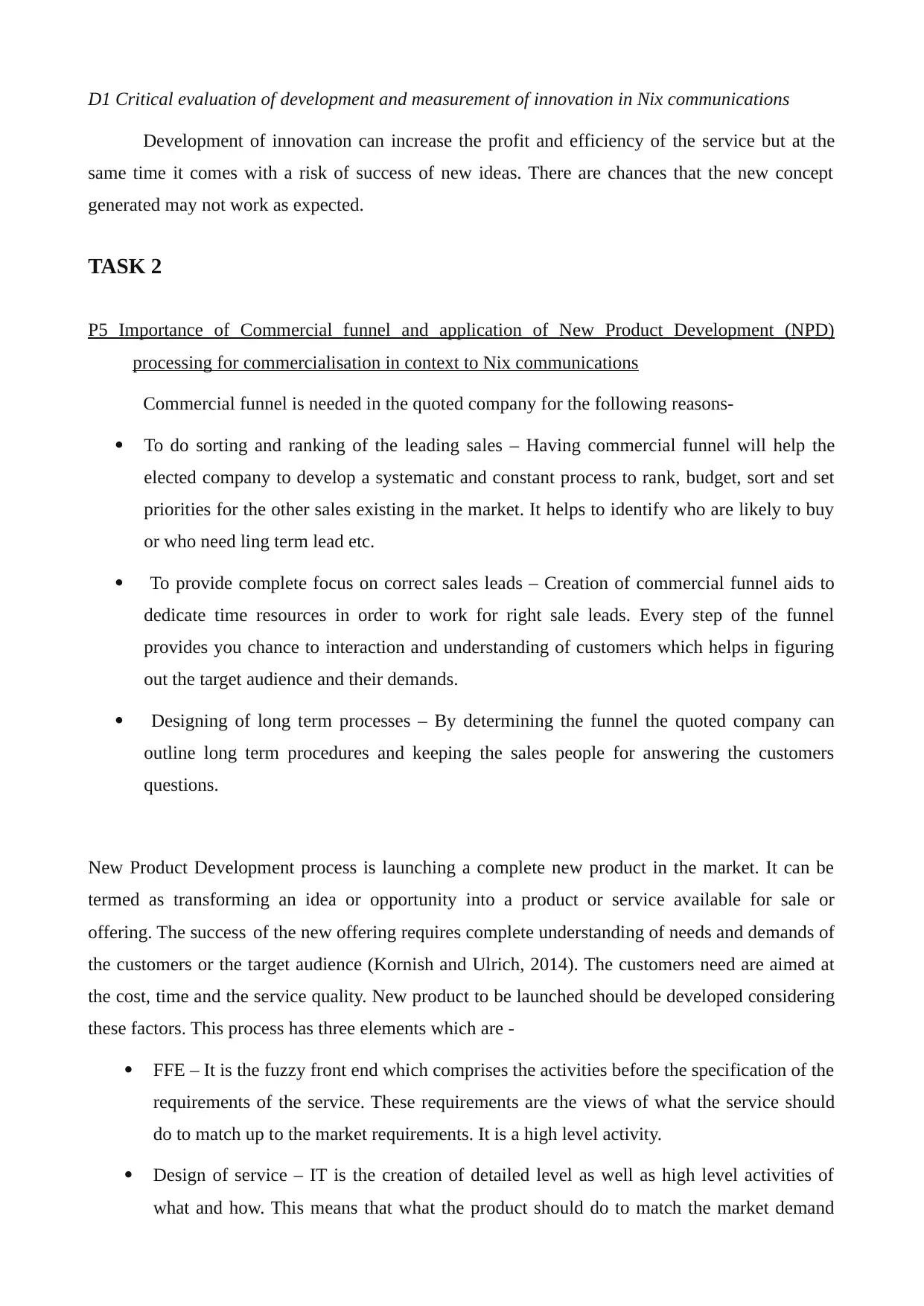
D1 Critical evaluation of development and measurement of innovation in Nix communications
Development of innovation can increase the profit and efficiency of the service but at the
same time it comes with a risk of success of new ideas. There are chances that the new concept
generated may not work as expected.
TASK 2
P5 Importance of Commercial funnel and application of New Product Development (NPD)
processing for commercialisation in context to Nix communications
Commercial funnel is needed in the quoted company for the following reasons-
To do sorting and ranking of the leading sales – Having commercial funnel will help the
elected company to develop a systematic and constant process to rank, budget, sort and set
priorities for the other sales existing in the market. It helps to identify who are likely to buy
or who need ling term lead etc.
To provide complete focus on correct sales leads – Creation of commercial funnel aids to
dedicate time resources in order to work for right sale leads. Every step of the funnel
provides you chance to interaction and understanding of customers which helps in figuring
out the target audience and their demands.
Designing of long term processes – By determining the funnel the quoted company can
outline long term procedures and keeping the sales people for answering the customers
questions.
New Product Development process is launching a complete new product in the market. It can be
termed as transforming an idea or opportunity into a product or service available for sale or
offering. The success of the new offering requires complete understanding of needs and demands of
the customers or the target audience (Kornish and Ulrich, 2014). The customers need are aimed at
the cost, time and the service quality. New product to be launched should be developed considering
these factors. This process has three elements which are -
FFE – It is the fuzzy front end which comprises the activities before the specification of the
requirements of the service. These requirements are the views of what the service should
do to match up to the market requirements. It is a high level activity.
Design of service – IT is the creation of detailed level as well as high level activities of
what and how. This means that what the product should do to match the market demand
Development of innovation can increase the profit and efficiency of the service but at the
same time it comes with a risk of success of new ideas. There are chances that the new concept
generated may not work as expected.
TASK 2
P5 Importance of Commercial funnel and application of New Product Development (NPD)
processing for commercialisation in context to Nix communications
Commercial funnel is needed in the quoted company for the following reasons-
To do sorting and ranking of the leading sales – Having commercial funnel will help the
elected company to develop a systematic and constant process to rank, budget, sort and set
priorities for the other sales existing in the market. It helps to identify who are likely to buy
or who need ling term lead etc.
To provide complete focus on correct sales leads – Creation of commercial funnel aids to
dedicate time resources in order to work for right sale leads. Every step of the funnel
provides you chance to interaction and understanding of customers which helps in figuring
out the target audience and their demands.
Designing of long term processes – By determining the funnel the quoted company can
outline long term procedures and keeping the sales people for answering the customers
questions.
New Product Development process is launching a complete new product in the market. It can be
termed as transforming an idea or opportunity into a product or service available for sale or
offering. The success of the new offering requires complete understanding of needs and demands of
the customers or the target audience (Kornish and Ulrich, 2014). The customers need are aimed at
the cost, time and the service quality. New product to be launched should be developed considering
these factors. This process has three elements which are -
FFE – It is the fuzzy front end which comprises the activities before the specification of the
requirements of the service. These requirements are the views of what the service should
do to match up to the market requirements. It is a high level activity.
Design of service – IT is the creation of detailed level as well as high level activities of
what and how. This means that what the product should do to match the market demand
Paraphrase This Document
Need a fresh take? Get an instant paraphrase of this document with our AI Paraphraser
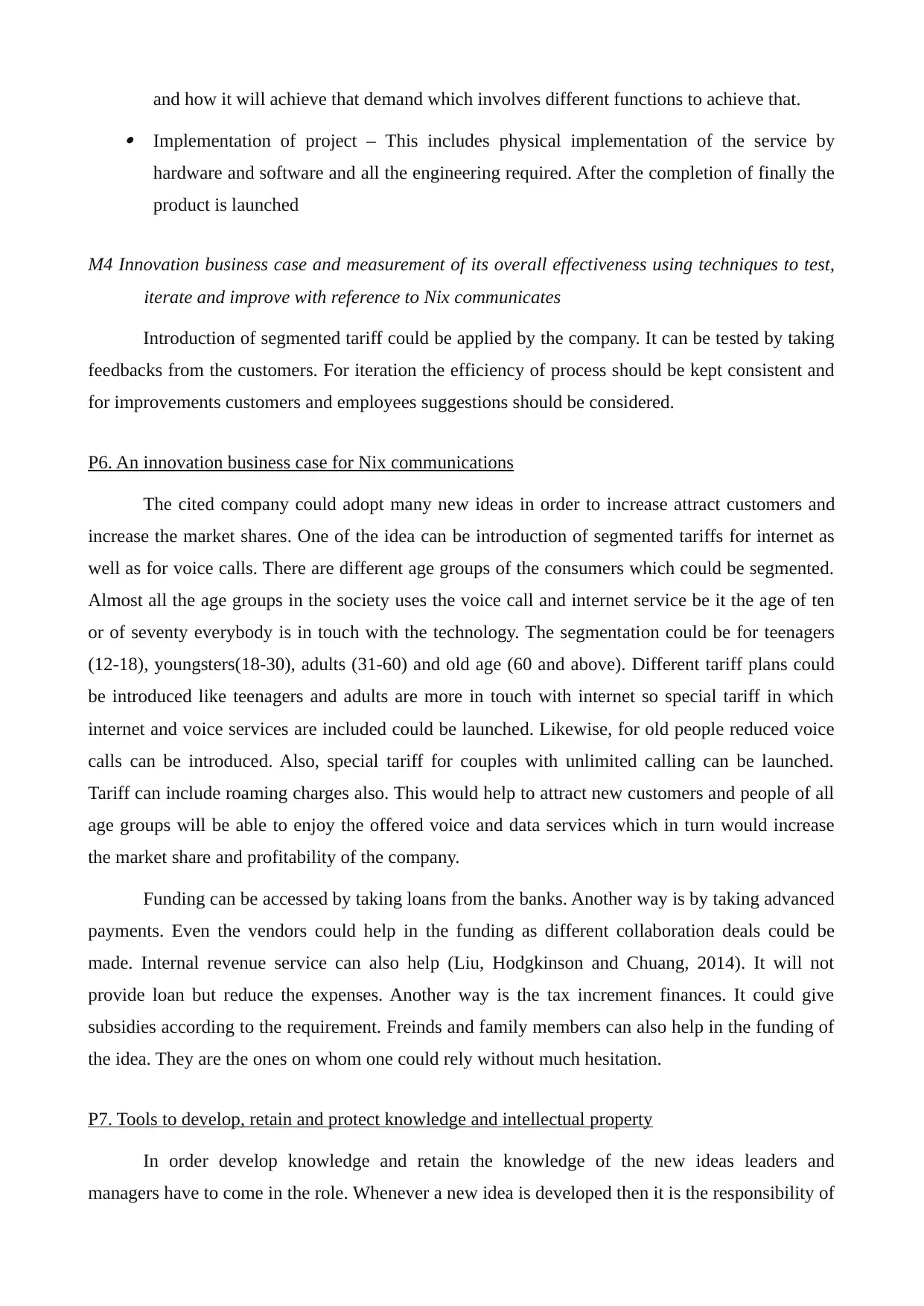
and how it will achieve that demand which involves different functions to achieve that. Implementation of project – This includes physical implementation of the service by
hardware and software and all the engineering required. After the completion of finally the
product is launched
M4 Innovation business case and measurement of its overall effectiveness using techniques to test,
iterate and improve with reference to Nix communicates
Introduction of segmented tariff could be applied by the company. It can be tested by taking
feedbacks from the customers. For iteration the efficiency of process should be kept consistent and
for improvements customers and employees suggestions should be considered.
P6. An innovation business case for Nix communications
The cited company could adopt many new ideas in order to increase attract customers and
increase the market shares. One of the idea can be introduction of segmented tariffs for internet as
well as for voice calls. There are different age groups of the consumers which could be segmented.
Almost all the age groups in the society uses the voice call and internet service be it the age of ten
or of seventy everybody is in touch with the technology. The segmentation could be for teenagers
(12-18), youngsters(18-30), adults (31-60) and old age (60 and above). Different tariff plans could
be introduced like teenagers and adults are more in touch with internet so special tariff in which
internet and voice services are included could be launched. Likewise, for old people reduced voice
calls can be introduced. Also, special tariff for couples with unlimited calling can be launched.
Tariff can include roaming charges also. This would help to attract new customers and people of all
age groups will be able to enjoy the offered voice and data services which in turn would increase
the market share and profitability of the company.
Funding can be accessed by taking loans from the banks. Another way is by taking advanced
payments. Even the vendors could help in the funding as different collaboration deals could be
made. Internal revenue service can also help (Liu, Hodgkinson and Chuang, 2014). It will not
provide loan but reduce the expenses. Another way is the tax increment finances. It could give
subsidies according to the requirement. Freinds and family members can also help in the funding of
the idea. They are the ones on whom one could rely without much hesitation.
P7. Tools to develop, retain and protect knowledge and intellectual property
In order develop knowledge and retain the knowledge of the new ideas leaders and
managers have to come in the role. Whenever a new idea is developed then it is the responsibility of
hardware and software and all the engineering required. After the completion of finally the
product is launched
M4 Innovation business case and measurement of its overall effectiveness using techniques to test,
iterate and improve with reference to Nix communicates
Introduction of segmented tariff could be applied by the company. It can be tested by taking
feedbacks from the customers. For iteration the efficiency of process should be kept consistent and
for improvements customers and employees suggestions should be considered.
P6. An innovation business case for Nix communications
The cited company could adopt many new ideas in order to increase attract customers and
increase the market shares. One of the idea can be introduction of segmented tariffs for internet as
well as for voice calls. There are different age groups of the consumers which could be segmented.
Almost all the age groups in the society uses the voice call and internet service be it the age of ten
or of seventy everybody is in touch with the technology. The segmentation could be for teenagers
(12-18), youngsters(18-30), adults (31-60) and old age (60 and above). Different tariff plans could
be introduced like teenagers and adults are more in touch with internet so special tariff in which
internet and voice services are included could be launched. Likewise, for old people reduced voice
calls can be introduced. Also, special tariff for couples with unlimited calling can be launched.
Tariff can include roaming charges also. This would help to attract new customers and people of all
age groups will be able to enjoy the offered voice and data services which in turn would increase
the market share and profitability of the company.
Funding can be accessed by taking loans from the banks. Another way is by taking advanced
payments. Even the vendors could help in the funding as different collaboration deals could be
made. Internal revenue service can also help (Liu, Hodgkinson and Chuang, 2014). It will not
provide loan but reduce the expenses. Another way is the tax increment finances. It could give
subsidies according to the requirement. Freinds and family members can also help in the funding of
the idea. They are the ones on whom one could rely without much hesitation.
P7. Tools to develop, retain and protect knowledge and intellectual property
In order develop knowledge and retain the knowledge of the new ideas leaders and
managers have to come in the role. Whenever a new idea is developed then it is the responsibility of
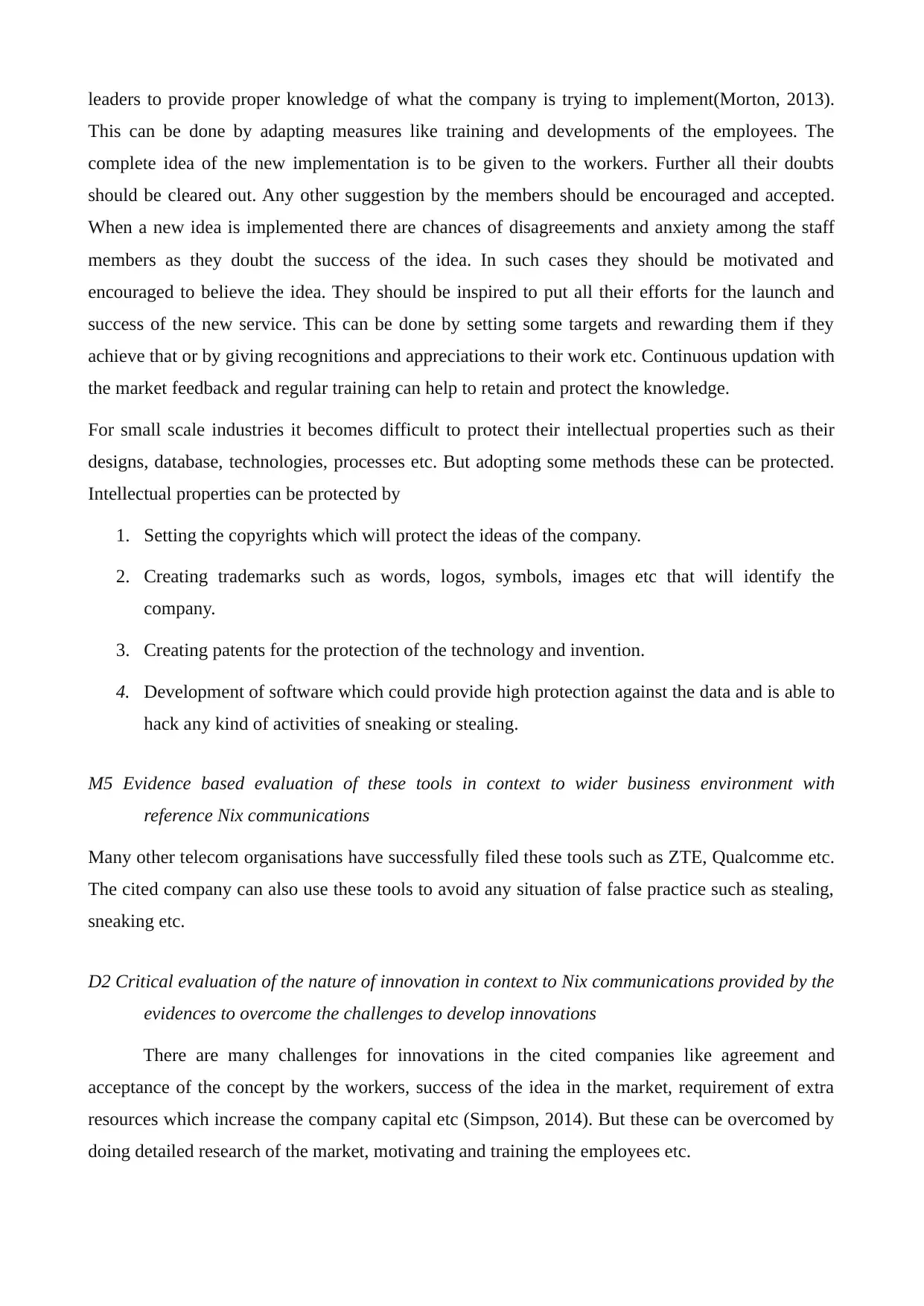
leaders to provide proper knowledge of what the company is trying to implement(Morton, 2013).
This can be done by adapting measures like training and developments of the employees. The
complete idea of the new implementation is to be given to the workers. Further all their doubts
should be cleared out. Any other suggestion by the members should be encouraged and accepted.
When a new idea is implemented there are chances of disagreements and anxiety among the staff
members as they doubt the success of the idea. In such cases they should be motivated and
encouraged to believe the idea. They should be inspired to put all their efforts for the launch and
success of the new service. This can be done by setting some targets and rewarding them if they
achieve that or by giving recognitions and appreciations to their work etc. Continuous updation with
the market feedback and regular training can help to retain and protect the knowledge.
For small scale industries it becomes difficult to protect their intellectual properties such as their
designs, database, technologies, processes etc. But adopting some methods these can be protected.
Intellectual properties can be protected by
1. Setting the copyrights which will protect the ideas of the company.
2. Creating trademarks such as words, logos, symbols, images etc that will identify the
company.
3. Creating patents for the protection of the technology and invention.
4. Development of software which could provide high protection against the data and is able to
hack any kind of activities of sneaking or stealing.
M5 Evidence based evaluation of these tools in context to wider business environment with
reference Nix communications
Many other telecom organisations have successfully filed these tools such as ZTE, Qualcomme etc.
The cited company can also use these tools to avoid any situation of false practice such as stealing,
sneaking etc.
D2 Critical evaluation of the nature of innovation in context to Nix communications provided by the
evidences to overcome the challenges to develop innovations
There are many challenges for innovations in the cited companies like agreement and
acceptance of the concept by the workers, success of the idea in the market, requirement of extra
resources which increase the company capital etc (Simpson, 2014). But these can be overcomed by
doing detailed research of the market, motivating and training the employees etc.
This can be done by adapting measures like training and developments of the employees. The
complete idea of the new implementation is to be given to the workers. Further all their doubts
should be cleared out. Any other suggestion by the members should be encouraged and accepted.
When a new idea is implemented there are chances of disagreements and anxiety among the staff
members as they doubt the success of the idea. In such cases they should be motivated and
encouraged to believe the idea. They should be inspired to put all their efforts for the launch and
success of the new service. This can be done by setting some targets and rewarding them if they
achieve that or by giving recognitions and appreciations to their work etc. Continuous updation with
the market feedback and regular training can help to retain and protect the knowledge.
For small scale industries it becomes difficult to protect their intellectual properties such as their
designs, database, technologies, processes etc. But adopting some methods these can be protected.
Intellectual properties can be protected by
1. Setting the copyrights which will protect the ideas of the company.
2. Creating trademarks such as words, logos, symbols, images etc that will identify the
company.
3. Creating patents for the protection of the technology and invention.
4. Development of software which could provide high protection against the data and is able to
hack any kind of activities of sneaking or stealing.
M5 Evidence based evaluation of these tools in context to wider business environment with
reference Nix communications
Many other telecom organisations have successfully filed these tools such as ZTE, Qualcomme etc.
The cited company can also use these tools to avoid any situation of false practice such as stealing,
sneaking etc.
D2 Critical evaluation of the nature of innovation in context to Nix communications provided by the
evidences to overcome the challenges to develop innovations
There are many challenges for innovations in the cited companies like agreement and
acceptance of the concept by the workers, success of the idea in the market, requirement of extra
resources which increase the company capital etc (Simpson, 2014). But these can be overcomed by
doing detailed research of the market, motivating and training the employees etc.
⊘ This is a preview!⊘
Do you want full access?
Subscribe today to unlock all pages.

Trusted by 1+ million students worldwide

CONCLUSIONS
Summing up the report reveals that innovation and commercialisation can be helpful for
offering the best possible service. Frugal innovation are another trending methods to make efficient
use of resources to get maximum benefit. Tools for protection and development of knowledge and
intellectual property needs to be used so that no false activity is practised and the database and
designs of the company are secured. Different type of innovation needs strategies and methodology
of implementation which have been discussed in the report. The report concludes that to stand out
amongst all the competitors and hold the position in the market innovations are necessary.
Summing up the report reveals that innovation and commercialisation can be helpful for
offering the best possible service. Frugal innovation are another trending methods to make efficient
use of resources to get maximum benefit. Tools for protection and development of knowledge and
intellectual property needs to be used so that no false activity is practised and the database and
designs of the company are secured. Different type of innovation needs strategies and methodology
of implementation which have been discussed in the report. The report concludes that to stand out
amongst all the competitors and hold the position in the market innovations are necessary.
Paraphrase This Document
Need a fresh take? Get an instant paraphrase of this document with our AI Paraphraser
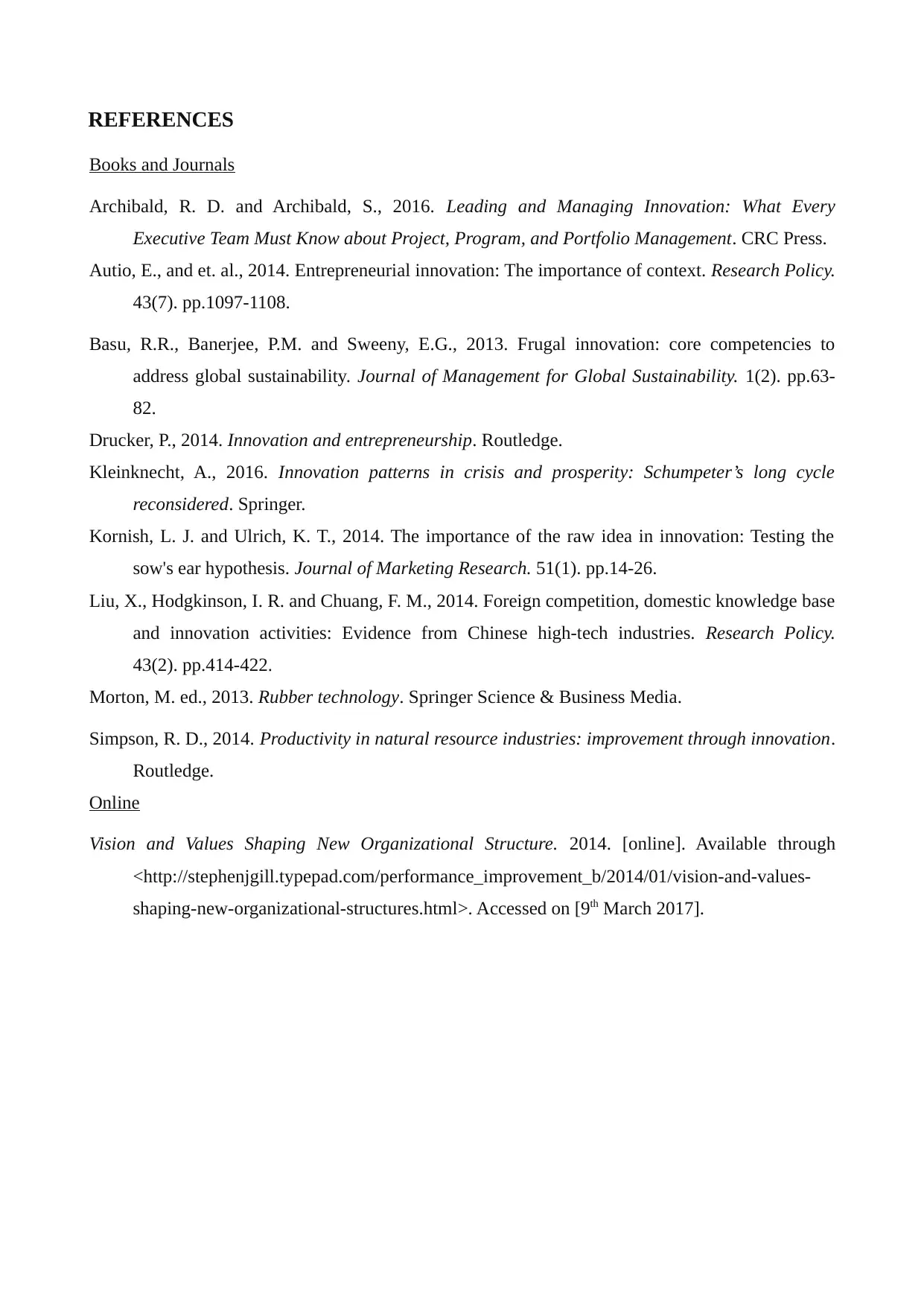
REFERENCES
Books and Journals
Archibald, R. D. and Archibald, S., 2016. Leading and Managing Innovation: What Every
Executive Team Must Know about Project, Program, and Portfolio Management. CRC Press.
Autio, E., and et. al., 2014. Entrepreneurial innovation: The importance of context. Research Policy.
43(7). pp.1097-1108.
Basu, R.R., Banerjee, P.M. and Sweeny, E.G., 2013. Frugal innovation: core competencies to
address global sustainability. Journal of Management for Global Sustainability. 1(2). pp.63-
82.
Drucker, P., 2014. Innovation and entrepreneurship. Routledge.
Kleinknecht, A., 2016. Innovation patterns in crisis and prosperity: Schumpeter’s long cycle
reconsidered. Springer.
Kornish, L. J. and Ulrich, K. T., 2014. The importance of the raw idea in innovation: Testing the
sow's ear hypothesis. Journal of Marketing Research. 51(1). pp.14-26.
Liu, X., Hodgkinson, I. R. and Chuang, F. M., 2014. Foreign competition, domestic knowledge base
and innovation activities: Evidence from Chinese high-tech industries. Research Policy.
43(2). pp.414-422.
Morton, M. ed., 2013. Rubber technology. Springer Science & Business Media.
Simpson, R. D., 2014. Productivity in natural resource industries: improvement through innovation.
Routledge.
Online
Vision and Values Shaping New Organizational Structure. 2014. [online]. Available through
<http://stephenjgill.typepad.com/performance_improvement_b/2014/01/vision-and-values-
shaping-new-organizational-structures.html>. Accessed on [9th March 2017].
Books and Journals
Archibald, R. D. and Archibald, S., 2016. Leading and Managing Innovation: What Every
Executive Team Must Know about Project, Program, and Portfolio Management. CRC Press.
Autio, E., and et. al., 2014. Entrepreneurial innovation: The importance of context. Research Policy.
43(7). pp.1097-1108.
Basu, R.R., Banerjee, P.M. and Sweeny, E.G., 2013. Frugal innovation: core competencies to
address global sustainability. Journal of Management for Global Sustainability. 1(2). pp.63-
82.
Drucker, P., 2014. Innovation and entrepreneurship. Routledge.
Kleinknecht, A., 2016. Innovation patterns in crisis and prosperity: Schumpeter’s long cycle
reconsidered. Springer.
Kornish, L. J. and Ulrich, K. T., 2014. The importance of the raw idea in innovation: Testing the
sow's ear hypothesis. Journal of Marketing Research. 51(1). pp.14-26.
Liu, X., Hodgkinson, I. R. and Chuang, F. M., 2014. Foreign competition, domestic knowledge base
and innovation activities: Evidence from Chinese high-tech industries. Research Policy.
43(2). pp.414-422.
Morton, M. ed., 2013. Rubber technology. Springer Science & Business Media.
Simpson, R. D., 2014. Productivity in natural resource industries: improvement through innovation.
Routledge.
Online
Vision and Values Shaping New Organizational Structure. 2014. [online]. Available through
<http://stephenjgill.typepad.com/performance_improvement_b/2014/01/vision-and-values-
shaping-new-organizational-structures.html>. Accessed on [9th March 2017].
1 out of 11
Related Documents
Your All-in-One AI-Powered Toolkit for Academic Success.
+13062052269
info@desklib.com
Available 24*7 on WhatsApp / Email
![[object Object]](/_next/static/media/star-bottom.7253800d.svg)
Unlock your academic potential
Copyright © 2020–2025 A2Z Services. All Rights Reserved. Developed and managed by ZUCOL.



![Innovation and Commercialisation Report - Unit 08: [College Name]](/_next/image/?url=https%3A%2F%2Fdesklib.com%2Fmedia%2Fimages%2Fdl%2F5be89891cd83445383609a2cae4964d9.jpg&w=256&q=75)

